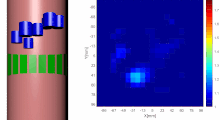Electrical capacitance tomography
Electrical capacitance tomography (ECT) is a method for determination of the dielectric permittivity distribution in the interior of an object from external capacitance measurements. It is a close relative of electrical impedance tomography[1] and is proposed as a method for industrial process monitoring, although it has yet to see widespread use. Potential applications include the measurement of flow of fluids in pipes[2] and measurement of the concentration of one fluid in another, or the distribution of a solid in a fluid.
Although capacitance sensing methods were in widespread use the idea of using capacitance measurement to form images is attributed to Maurice Beck and co-workers at UMIST in the 1980s.[3]
Although usually called tomography, the technique differs from conventional tomographic methods, in which high resolution images are formed of slices of a material. The measurement electrodes, which are metallic plates, must be sufficiently large to give a measureable change in capacitance. This means that very few electrodes are used and eight or twelve electrodes is common. An N-electrode system can only provide N(N−1)/2 independent measurements. This means that the technique is limited to producing very low resolution images of approximate slices. However, ECT is fast, and relatively inexpensive.
| This article uses material from the Wikipedia article Metasyntactic variable, which is released under the Creative Commons Attribution-ShareAlike 3.0 Unported License. |

